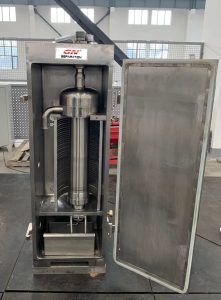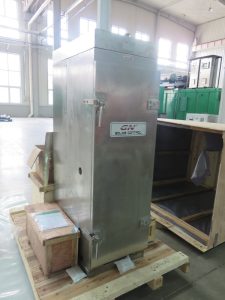As the biotechnology industry expands in the Middle East, the need for efficient separation techniques becomes crucial. One such technique is the use of tubular centrifuges. In this article, we will explore the application of the GNGQ142 tubular centrifuge in a Middle East biotechnology company for the separation of microbial fermentation broth. This centrifuge offers several notable features, including 316L material construction, cooling coils for temperature control, and a variable frequency control box for adjustable speed. With these features, the GNGQ142 tubular centrifuge provides an effective solution for the separation of microbial fermentation broth in the biotechnology industry.
1. Introduction to Tubular Centrifuges
A tubular centrifuge is a type of centrifuge that is commonly used in separation processes. In this article, we will provide an overview of tubular centrifuges and their role in the separation of microbial fermentation broth.
One key feature of the tubular centrifuge model GNGQ142 is its rotor material, which is made of 316L stainless steel. This material is known for its excellent corrosion resistance and is therefore suitable for applications in the biotechnology industry. The use of 316L stainless steel ensures that the centrifuge can withstand the harsh conditions of the separation process.
Another important feature of the GNGQ142 is the inclusion of cooling coils. These coils are designed to maintain the working temperature of the material being separated. This is particularly crucial in the case of microbial fermentation broth, as certain temperature ranges need to be maintained for optimal separation efficiency. The cooling coils ensure that the temperature of the material remains within the desired range, thus ensuring reliable and effective separation.
The GNGQ142 also includes a stainless steel variable frequency control box. This control box allows for the adjustment of the centrifuge’s speed, which is a critical parameter in the separation process. The ability to control the speed allows for the optimization of separation conditions, leading to improved separation efficiency and product quality. Additionally, the control box features speed and temperature displays, providing operators with real-time information on the operating conditions of the centrifuge.
In conclusion, the tubular centrifuge model GNGQ142 is a versatile and efficient tool for the separation of microbial fermentation broth. Its 316L stainless steel rotor provides excellent corrosion resistance, while the inclusion of cooling coils ensures proper temperature control. The stainless steel variable frequency control box allows for speed adjustment, providing flexibility in separation conditions. Overall, the GNGQ142 offers a reliable and effective solution for the separation needs of the Middle East biotechnology company.
2 Application in the Middle East Biotechnology Industry
In the Middle East biotechnology industry, the GNGQ142 tubular centrifuge finds its specific application in the separation of microbial fermentation broth. This centrifuge model is equipped with advanced features to ensure efficient separation and maintain the quality of the separated material.
One of the key features of the GNGQ142 tubular centrifuge is its rotor material, which is made of 316L stainless steel. This material provides excellent corrosion resistance and durability, making it ideal for handling the harsh conditions of the biotechnology industry. The use of 316L stainless steel ensures that the centrifuge can withstand the corrosive nature of the microbial fermentation broth without compromising its performance.
To maintain the working temperature of the material, the GNGQ142 tubular centrifuge is equipped with cooling coils. These cooling coils help regulate the temperature of the material during the separation process, ensuring that it remains within the desired range. This feature is particularly important in the biotechnology industry, where maintaining the integrity of the separated material is crucial for downstream processes.
In addition to its robust design and temperature control capabilities, the GNGQ142 tubular centrifuge also features a stainless steel variable frequency control box. This control box allows the user to adjust the speed of the centrifuge according to the specific requirements of the separation process. The adjustable speed feature ensures that the centrifuge can handle different types of microbial fermentation broth effectively.
Furthermore, the GNGQ142 tubular centrifuge is equipped with a speed display and a temperature display. These displays provide real-time monitoring of the centrifuge’s operation, allowing the user to track the speed and temperature of the separation process. This feature enables precise control and optimization of the separation process, leading to better overall efficiency and product quality.
In summary, the GNGQ142 tubular centrifuge has found its specific application in the Middle East biotechnology industry for the separation of microbial fermentation broth. With its 316L stainless steel rotor, cooling coils for temperature control, stainless steel variable frequency control box with adjustable speed, speed display, and temperature display, this centrifuge model offers the necessary features and capabilities to ensure efficient separation and maintain the quality of the separated material.
3 Notable Features of the GNGQ142 Tubular Centrifuge
The GNGQ142 tubular centrifuge is equipped with several notable features that contribute to its effectiveness in separating microbial fermentation broth. One key feature of this centrifuge is its rotor material, which is constructed from 316L stainless steel. The use of this material ensures the durability and corrosion resistance of the centrifuge, making it suitable for continuous and long-term operation in biotechnology applications.
In addition to its robust construction, the GNGQ142 tubular centrifuge also includes cooling coils, which play a crucial role in maintaining the working temperature of the material being separated. The cooling coils are designed to dissipate heat generated during the centrifugal process, preventing any undesirable changes in the temperature of the fermentation broth. This feature is particularly important in biotechnology applications, where maintaining the optimal temperature is crucial for the viability and integrity of the separated components.
Furthermore, the GNGQ142 tubular centrifuge is equipped with a stainless steel variable frequency control box, which allows for precise control of the centrifuge’s speed. The adjustable speed function enables operators to customize the centrifugal process based on the specific characteristics of the microbial fermentation broth, ensuring optimal separation efficiency. The speed display feature provides real-time feedback on the rotational speed, allowing operators to monitor and adjust the centrifuge accordingly. Additionally, the temperature display feature enables operators to monitor the working temperature of the material, ensuring that it remains within the desired range throughout the separation process.
In conclusion, the GNGQ142 tubular centrifuge offers several notable features that enhance its performance in separating microbial fermentation broth. The 316L stainless steel rotor material, cooling coils, and stainless steel variable frequency control box with adjustable speed, speed display, and temperature display collectively contribute to the efficiency and effectiveness of this centrifuge. Its robust construction and precise control capabilities make it a reliable choice for biotechnology companies in the Middle East and beyond.
4 Advantages and Benefits of the GNGQ142 Tubular Centrifuge
The GNGQ142 tubular centrifuge offers numerous advantages and benefits for the separation of microbial fermentation broth in the biotechnology industry.
One of the key advantages of the GNGQ142 tubular centrifuge is its rotor material, which is made of 316L stainless steel. This material is highly resistant to corrosion, ensuring the durability and longevity of the centrifuge. The 316L stainless steel also has excellent mechanical properties, making it well-suited for high-speed rotation and efficient separation of the fermentation broth.
Another notable feature of the GNGQ142 tubular centrifuge is the inclusion of cooling coils. These cooling coils help maintain the working temperature of the material during the separation process. By keeping the material at the optimal temperature, the centrifuge ensures consistent and efficient separation, resulting in high-quality output.
The GNGQ142 tubular centrifuge is equipped with a stainless steel variable frequency control box, which offers adjustable speed settings. This allows for precise control of the centrifuge’s rotation speed, enabling operators to optimize the separation process based on the specific characteristics of the microbial fermentation broth. Furthermore, the control box also features a speed display and temperature display, providing real-time monitoring and feedback for enhanced operational control and efficiency.
In addition to its technical features, the GNGQ142 tubular centrifuge also offers practical benefits. Its compact design and small footprint make it easy to integrate into existing biotechnology production lines, saving valuable floor space. The centrifuge is also designed for ease of use, with intuitive controls and user-friendly interface, minimizing the learning curve for operators and reducing the likelihood of errors.
Overall, the GNGQ142 tubular centrifuge is an excellent choice for the separation of microbial fermentation broth in the biotechnology industry. With its 316L stainless steel rotor, cooling coils, variable frequency control box, and practical benefits, it offers reliable performance, precise control, and efficient separation, contributing to improved productivity and high-quality output. The advantages and benefits of the GNGQ142 tubular centrifuge make it a valuable asset for biotechnology companies seeking to optimize their fermentation processes.
In conclusion, the GNGQ142 tubular centrifuge is a valuable asset for the Middle East biotechnology company in their quest for efficient separation techniques. With its 316L material construction, cooling coils, and variable frequency control box, this centrifuge offers the necessary features for the separation of microbial fermentation broth. Its adjustable speed, speed display, and temperature display further enhance its usability and effectiveness. As the biotechnology industry continues to grow in the Middle East, the adoption of advanced separation techniques such as the GNGQ142 tubular centrifuge will play a crucial role in accelerating research and development processes.
